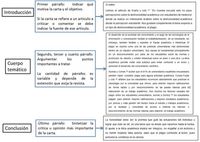Resumen
Una carta al editor es un tipo de publicación científica que se clasifica como “comunicación corta” y que permite a los lectores interactuar con los autores ya sea a través de opiniones, críticas, aportes, ideas, hipótesis y nuevos datos. En el presente artículo se realizó una revisión bibliográfica sobre las principales consideraciones para la redacción y elaboración de una carta al editor. Se exploró los artículos de las bases de datos PubMed, Scopus y SciELO desde el año 2010 (enero) hasta la actualidad (diciembre del 2020). La carta al editor como publicación científica presenta consideraciones para su redacción y construcción que pueden hacer referencia a un artículo publicado en la revista, así como a una temática coyuntural o aporte del lector. Permite confrontar las ideas publicadas por los investigadores con una comunidad académica. Desde un enfoque pedagógico permite a un estudiante e investigador novel iniciarse en el mundo de la crítica y redacción científica; asimismo conocer el proceso editorial de envío y publicación de artículos científicos.
Referencias
2. Anthony R. From the Editor: What's a letter to the editor? J Occup Environ Hyg. 2019. [Acceso: 04/07/2020];16(1):D1-D2. Disponible en: https://pubmed.ncbi.nlm.nih.gov/30856088/
3.Falavarjani KG, Kashkouli MB, Chams H. Letter to Editor, a scientific forum for discussion. J Curr Ophthalmol. 2016. [Acceso: 04/07/2020];28(1):1-2. Disponible en: https://pubmed.ncbi.nlm.nih.gov/27239593/
4. Süer E, Yaman Ö. How to write an editorial letter? Turkish J Urol. 2013. [Acceso: 04/07/2020];39(Suppl 1):41-3. Disponible en: https://www.turkishjournalofurology.com/en/how-to-write-an-editorial-letter-13435
5. Dkhar SA. Letter to editor: its importance and drawbacks. Int J Community Med Public Health. 2018. [Acceso: 04/07/2020];5:4634-6. Disponible en: https://www.semanticscholar.org/paper/Letter-to-editor%3A-its-importance-and-drawbacks-Dkhar/f6c43031714b842a84f785c912e83a5d20d0d4d6
6. International Committee of Medical Journal Editors. Uniform requirements for manuscripts submitted to biomedical journals: publishing and editorial issues related to publication in biomedical journals: correspondence. [Acceso: 04/07/2020]. Disponible en: www.icmje.org/ publishing_5correspond.html.
7. Jadhav S, Bavdekar SB. Letter to Editor: Keeping the Dialogue Going. J Assoc Physicians India. 2015. [Acceso: 05/08/2020];63(5):55-57. Disponible en: https://pubmed.ncbi.nlm.nih.gov/26591146/
8. Anstey A. Letters to the editor: time for more scholarly debate. Br J Dermatol. 2014. [Acceso: 05/08/2020];171(1):1–2. Disponible en: https://onlinelibrary.wiley.com/doi/full/10.1111/bjd.13134
9. Why Write a Letter to the Editor?. Adv Neonatal Care. 2017. [Acceso: 05/08/2020];17(2):77-78. Disponible en: https://pubmed.ncbi.nlm.nih.gov/28362696/
10. López-Hernández D; Brito-Aranda L, Torres-Fonseca, A. Importancia y redacción de la carta al editor. Revista de Especialidades Médico Quirúrgicas. [Acceso: 05/08/2020]; 19(4): 475-478. Disponible en: https://www.medigraphic.com/cgi-bin/new/resumen.cgi?IDARTICULO=54588
11. Sosa-Gonzalo SL, Aveiro-Róbalo TR, Galán-Rodas E. Cartas al editor: Importancia y recomendaciones para su redacción. CIMEL. 2016. [Acceso: 05/08/2020]; 21(2): 48- 50. Disponible en: https://www.cimel.felsocem.net/index.php/CIMEL/article/view/643/361
12. Tierney E, O’Rourke C, Fenton JE. What is the role of 'the letter to the editor'? Eur Arch Otorhinolaryngol. 2015. [Acceso: 05/08/2020];272:2089. Disponible en: https://pubmed.ncbi.nlm.nih.gov/25231709/
13. Montenegro-Idrogo JJ, Mejía-Dolores JW, Chalco-Huamán JL. Cartas al editor publicadas en revistas biomédicas peruanas indizadas en SciELO- Perú 2006-2013. Rev Peru Med Exp Salud Publica. 2015. [Acceso: 05/08/2020];32(1):104–9. Disponible en: http://www.scielo.org.pe/scielo.php?script=sci_arttext&pid=S1726-46342015000100016
14. Revista de Investigación Clínica. Instrucciones a los autores. [Acceso: 05/08/2020]. Disponible en: http://www.scielo.org.mx/revistas/ric/einstruc.htm
15. Fernández-Esteve, García AM. Sr. Director: La importancia de las Cartas al Director. Gac Sanit. 2005. [Acceso: 05/08/2020];19(5):354-355. Disponible en: http://scielo.isciii.es/scielo.php?script=sci_arttext&pid=S0213-91112005000500002
16. Miyahira JM. Importancia de las Cartas al editor. Rev Med Hered. 2010. [Acceso: 08/08/2020];21:57-58.Disponible en: http://www.scielo.org.pe/scielo.php?script=sci_arttext&pid=S1018-130X2010000200001
17. Peh WC, Ng KH. Writing a letter to the Editor. Singapore Med J. 2010. [Acceso: 08/08/2020];51(7):532–5. Disponible en: https://pubmed.ncbi.nlm.nih.gov/20730391/
18. Gokani SA, Sharma E, Sharma T, Moudhgalya SV, Selvendran SS, Aggarwal N. Impact of a National Journal Club and Letter Writing Session on Improving Medical Students' Confidence with Critical Appraisal. Adv Med Educ Pract. 2019. [Acceso: 08/08/2020];10:1081-1087. Disponible en: https://pubmed.ncbi.nlm.nih.gov/31920419/
19. Miyahira JM. La investigación formativa y la formación para la investigación en el pregrado. Rev Med Hered. 2009. [Acceso: 08/08/2020];20(3):119-122. Disponible en: https://www.researchgate.net/publication/262442184_La_investigacion_formativa_y_la_formacion_para_la_investigacion_en_el_pregrado
20. Castro-Rodríguez Y. La lectura de artículos científicos. Entrevista a estudiantes del pregrado. Odontol. Sanmarquina. 2020. [Acceso: 08/08/2020]; 23(1): 93-95. Disponible en: https://revistasinvestigacion.unmsm.edu.pe/index.php/odont/article/view/17516
21. Caballero-Ortiz AG. Cartas al editor como oportunidad de primera publicación en los miembros de FELSOCEM. CIMEL. 2015. [Acceso: 08/08/2020]; 19(2). Disponible en: http://www.cimel.felsocem.net/index.php/CIMEL/article/viewArticle/494
22. Spodick DH, Goldberg RJ. The editor's correspondence: analysis of patterns appearing in selected specialty and general journals. Am J Cardiol. 1983 [Acceso: 20/02/2021]; 52: 1290- 1292. Disponible en: https://pubmed.ncbi.nlm.nih.gov/6650419/
23. Johnson C, Green B. How to write a letter to the editor: an author’s guide. J Chiropr Med. 2006. [Acceso: 08/08/2020];5(4):144–7. Disponible en: https://www.ncbi.nlm.nih.gov/pmc/articles/PMC2647072/
24. Kearney MH. Write to Me Please: The Scholarly Importance of Letters to the Editor. Res Nurs Health. 2015. [Acceso: 08/08/2020];38(5):327–9. Disponible en: https://pubmed.ncbi.nlm.nih.gov/26291520/
25. Sturpe D, Kolar C, Janke K. Enhancing scholarly dialogue: Inviting Letters to the Editor. Curr Pharm Teach Learn. 2016. [Acceso: 08/08/2020];8(3):269–70. Disponible en: https://pubmed.ncbi.nlm.nih.gov/30070234/
26. Clouet D. Cartas al Editor: Algo más que 1.000 palabras. Rev Med Chile. 2014. [Acceso: 08/08/2020]; 142: 677-678. Disponible en: https://scielo.conicyt.cl/scielo.php?script=sci_arttext&pid=S0034-98872014000500021
27. Brown CJ. Letters to the editor provide a forum for readers and help make a journal accountable to the medical fraternity. Can Med Assoc J. 1997; 157:792-4.
28. Moffatt B. Scientific authorship, pluralism, and practice. Account Res. 2018. [Acceso: 08/08/2020];25(4):199-211. Disponible en: https://pubmed.ncbi.nlm.nih.gov/29400074/
29. Neghina R, Neghina AM. How to build a scientific publishing career based on hundreds of letters-to-the-editor: ―The Art of Loss‖. Account Res. 2011. [Acceso: 08/08/2020];18(4):247–9. Disponible en: https://www.unboundmedicine.com/medline/citation/21707416/How_to_build_a_scientific_publishing_career_based_on_hundreds_of_letters_to_the_editor:_%22The_Art_of_Loss%22_


